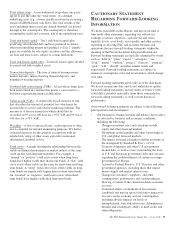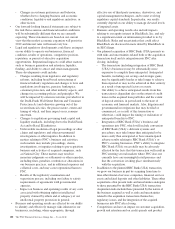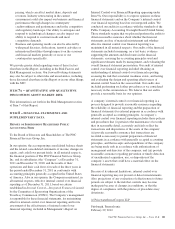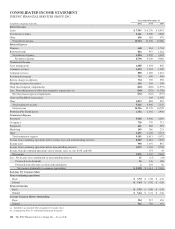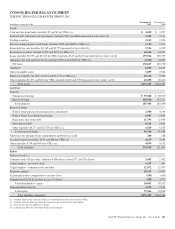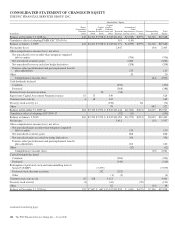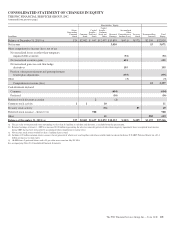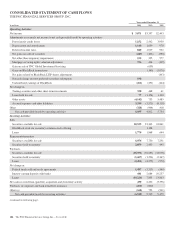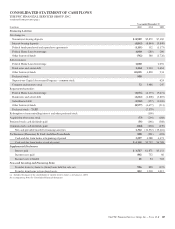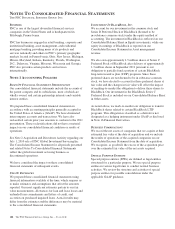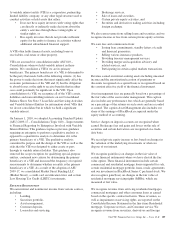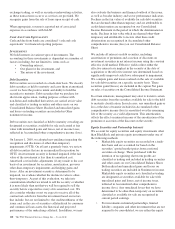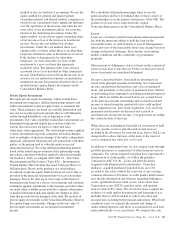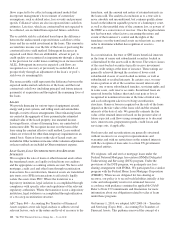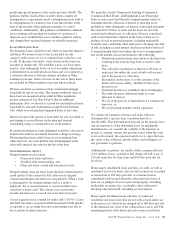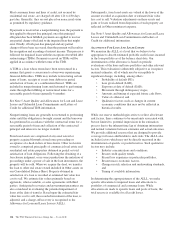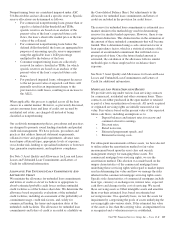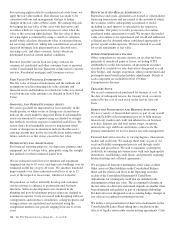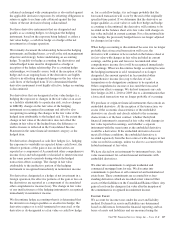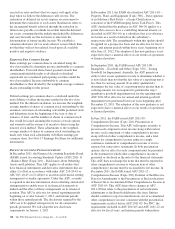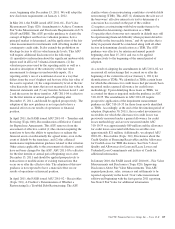PNC Bank 2011 Annual Report Download - page 118
Download and view the complete annual report
Please find page 118 of the 2011 PNC Bank annual report below. You can navigate through the pages in the report by either clicking on the pages listed below, or by using the keyword search tool below to find specific information within the annual report.A variable interest entity (VIE) is a corporation, partnership,
limited liability company, or any other legal structure used to
conduct activities or hold assets that either:
• Does not have equity investors with voting rights that
can directly or indirectly make decisions about the
entity’s activities through those voting rights or
similar rights, or
• Has equity investors that do not provide sufficient
equity for the entity to finance its activities without
additional subordinated financial support.
A VIE often holds financial assets, including loans or
receivables, real estate or other property.
VIEs are assessed for consolidation under ASC 810 –
Consolidations when we hold variable interest in these
entities. We consolidate a VIE if we are its primary
beneficiary. The primary beneficiary of a VIE is determined to
be the party that meets both of the following criteria: (1) has
the power to make decisions that most significantly affect the
economic performance of the VIE and (2) has the obligation
to absorb losses or the right to receive benefits that in either
case could potentially be significant to the VIE. Upon
consolidation of a VIE, we recognize all of the VIE’s assets,
liabilities and noncontrolling interests on our Consolidated
Balance Sheet. See Note 3 Loan Sale and Servicing Activities
and Variable Interest Entities for information about VIEs that
we do not consolidate but in which we hold a significant
variable interest.
On January 1, 2010, we adopted Accounting Standard Update
(ASU) 2009-17 – Consolidations (Topic 810) – Improvements
to Financial Reporting by Enterprises Involved with Variable
Interest Entities. This guidance replaces previous guidance
requiring an enterprise to perform a qualitative analysis as
opposed to a quantitative analysis to determine if it is the
primary beneficiary of a VIE. The qualitative analysis
considers the purpose and the design of the VIE as well as the
risks that the VIE was designed to either create or pass
through to variable interest holders. This guidance also
removed the scope exception for qualifying special-purpose
entities, contained new criteria for determining the primary
beneficiary of a VIE and increased the frequency of required
reassessments to determine whether an entity is the primary
beneficiary of a VIE. As a result of the adoption of ASU
2009-17, we consolidated Market Street Funding LLC
(Market Street), a credit card securitization trust, and certain
Low Housing Tax Credit (LIHTC) investments.
R
EVENUE
R
ECOGNITION
We earn interest and noninterest income from various sources,
including:
• Lending,
• Securities portfolio,
• Asset management,
• Customer deposits,
• Loan sales and servicing,
• Brokerage services,
• Sale of loans and securities,
• Certain private equity activities, and
• Securities and derivatives trading activities including
foreign exchange.
We also earn revenue from selling loans and securities and we
recognize income or loss from certain private equity activities.
We earn fees and commissions from:
• Issuing loan commitments, standby letters of credit
and financial guarantees,
• Selling various insurance products,
• Providing treasury management services,
• Providing merger and acquisition advisory and
related services, and
• Participating in certain capital markets transactions.
Revenue earned on interest-earning assets including unearned
income and the amortization/accretion of premiums or
discounts recognized on acquired loans is recognized based on
the constant effective yield of the financial instrument.
Asset management fees are generally based on a percentage of
the fair value of the assets under management. This caption
also includes any performance fees which are generally based
on a percentage of the returns on such assets and are recorded
as earned. The caption Asset Management also includes our
share of the earnings of BlackRock recognized under the
equity method of accounting.
Service charges on deposit accounts are recognized when
earned. Brokerage fees and gains and losses on the sale of
securities and certain derivatives are recognized on a trade-
date basis.
We record private equity income or loss based on changes in
the valuation of the underlying investments or when we
dispose of our interest.
We recognize gain/(loss) on changes in the fair value of
certain financial instruments where we have elected the fair
value option. These financial instruments include certain
commercial and residential mortgage loans originated for sale,
certain residential mortgage portfolio loans, resale agreements
and our investment in BlackRock Series C preferred stock. We
also recognize gain/(loss) on changes in the fair value of
residential mortgage servicing rights (MSRs), which are
measured at fair value.
We recognize revenue from servicing residential mortgages,
commercial mortgages and other consumer loans as earned
based on the specific contractual terms. These revenues, as
well as impairment on servicing rights, are reported on the
Consolidated Income Statement in the line items Residential
mortgage, Corporate services, and Consumer service We
recognize revenue from securities, derivatives and foreign
The PNC Financial Services Group, Inc. – Form 10-K 109


